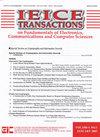A SAT approach to the initial mapping problem in SWAP gate insertion for commuting gates
IF 0.4
4区 计算机科学
Q3 Computer Science
Ieice Transactions on Fundamentals of Electronics Communications and Computer Sciences
Pub Date : 2022-12-12
DOI:10.1587/transfun.2022EAP1159
引用次数: 3
Abstract
Most quantum circuits require SWAP gate insertion to run on quantum hardware with limited qubit connectivity. A promising SWAP gate insertion method for blocks of commuting two-qubit gates is a predetermined swap strategy which applies layers of SWAP gates simultaneously executable on the coupling map. A good initial mapping for the swap strategy reduces the number of required swap gates. However, even when a circuit consists of commuting gates, e.g., as in the Quantum Approximate Optimization Algorithm (QAOA) or trotterized simulations of Ising Hamiltonians, finding a good initial mapping is a hard problem. We present a SAT-based approach to find good initial mappings for circuits with commuting gates transpiled to the hardware with swap strategies. Our method achieves a 65% reduction in gate count for random three-regular graphs with 500 nodes. In addition, we present a heuristic approach that combines the SAT formulation with a clustering algorithm to reduce large problems to a manageable size. This approach reduces the number of swap layers by 25% compared to both a trivial and random initial mapping for a random three-regular graph with 1000 nodes. Good initial mappings will therefore enable the study of quantum algorithms, such as QAOA and Ising Hamiltonian simulation applied to sparse problems, on noisy quantum hardware with several hundreds of qubits.交换门SWAP门插入初始映射问题的SAT方法
大多数量子电路需要SWAP门插入才能在量子比特连接有限的量子硬件上运行。一种很有前途的交换门插入方法是在耦合映射上应用同时可执行的交换门层的预定交换策略。交换策略的良好初始映射可以减少所需交换门的数量。然而,即使一个电路由交换门组成,例如,在量子近似优化算法(QAOA)或伊辛哈密顿算子的troterized模拟中,找到一个好的初始映射是一个难题。我们提出了一种基于sat的方法,用于寻找具有交换策略的交换门转换到硬件的电路的良好初始映射。我们的方法实现了具有500个节点的随机三正则图的门数减少65%。此外,我们提出了一种启发式方法,将SAT公式与聚类算法相结合,将大问题减少到可管理的规模。与具有1000个节点的随机三正则图的普通和随机初始映射相比,这种方法将交换层的数量减少了25%。因此,良好的初始映射将使量子算法的研究成为可能,例如QAOA和应用于稀疏问题的伊辛哈密顿模拟,这些算法都是在具有数百个量子比特的噪声量子硬件上进行的。
本文章由计算机程序翻译,如有差异,请以英文原文为准。
求助全文
约1分钟内获得全文
求助全文
来源期刊

Ieice Transactions on Fundamentals of Electronics Communications and Computer Sciences
COMPUTER SCIENCE, HARDWARE & ARCHITECTURE-COMPUTER SCIENCE, INFORMATION SYSTEMS
CiteScore
1.10
自引率
20.00%
发文量
0
 求助内容:
求助内容: 应助结果提醒方式:
应助结果提醒方式:


